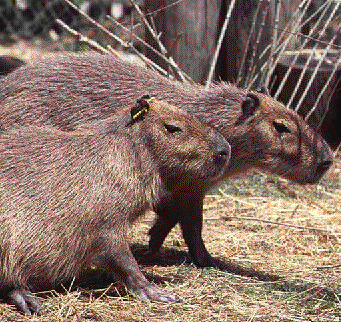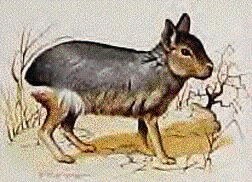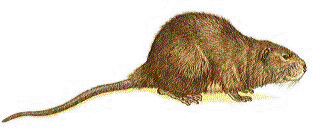
Did you know that your sweet and cuddly
cavy has quite a few interesting relatives, most living in South
America? The domestic cavy (scientific name: cavia porcellus)
originated in South America, where wild species still exist today.
Cavies are probably one of the earliest
animals to be kept by man for food and companionship. Remains
of cavies have been found buried with mummies in tombs of the
ancient Incas. Some Incan tribes used cavies as sacrificial offerings
to their gods. Indians of Peru, Columbia and Ecuador raised cavies
in large numbers for meat and fur long before outsiders arrived
at their shores. Those domestic cavies were pretty basic, none
of the fancy coat, color and patterns that we have today.
 |
Around 1540 Spanish sailors took cavies
aboard ships returning from explorations into South America.
Some were eaten as fresh meat, others traveled to new homes throughout
Europe. They became popular as pets, even endearing themselves
to Queen Elizabeth I. It is unclear when cavies were brought
to North America, but they probably arrived with early explorers
and settlers. During WWII Italians were encouraged by their government
to raise cavies as food to supplement meager war rations. Cavies
are still kept as friendly livestock in parts of South America.
In Peru cavies are called "cuis", pronounced "kwees".
|
I can tell you right now, none of these
people would have passed my cavy adoption interview. No breeding!
And absolutely no eating!
Wild cavies are still found in a wide
range of habitats from Columbia and Venezuela down to Brazil
and northern Argentina. Cavies in the western regions (scientific
name: cavia aperea tschudii) are thought to be the wild
breed closest to our pets ancestors. Swampland, grassland, rocky
mountain areas, plant covered foothills and forest edges are
home to various species of cavy. All are active during the day,
feeding on local vegetation, grasses and even the fleshy part
of cacti. Most prefer to use abandoned dens of other animals,
but can dig their own if necessary. They may also tunnel into
dense grass or thickets for shelter. A few swampland breeds have
no dens at all.
Fast and agile, wild cavies can run quickly
through the underbrush, following maze-like trails. Living in
herds of 4-20, these cavies often move single file as a group
from one area to another - keeping close contact with each other.
Cavies warn each other of danger by whistling and squealing,
a signal to run and hide in thickets, crevices or dens. Even
pups only a few hours old are agile enough to have a chance at
eluding predators. If surprised by a predator, a cavy may save
himself by staying quiet and completely still.
The rock cavy (or moko) is the Olympic
champion of the cavy world. This athletic specimen can jump several
yards, move quickly and easily over rocky terrain and cliffs,
and even climb trees for a leafy snack. The Berlin Zoo once had
a rock cavy that climbed the smooth glass and concrete walls
of its enclosure. They prefer to live under boulders and in crevices
of mountain areas in southern Brazil.
Wild cavies are a muddy gray/brown color
with dark eyes. They are smaller than our pet cavies, with a
pointed nose and longer back legs. One book notes that wild cavies
have a small stomach, short small-intestine, long cecum and large-intestine.
This is opposite of our pet's large stomach, long small-intestine,
short cecum and large-intestine. Wild cavies poop more (hard
to believe with some of the little "poop machines"
I've owned). Wild cavies are also faster and more agile than
our little lap pigs. The golden agouti (black hair tipped with
red) or cinnamon agouti (chocolate hair tipped with red) colored
American cavy, with it's short smooth coat, would probably most
resemble the wild cavy.
 |
Cavies have some very unique and interesting
cousins. My favorite is the capybara, known as the world's largest
rodent. This cutie looks like a cross between a chocolate colored
guinea pig and a hippopotamus. I want one! Adults are 4-4 ½
feet long and weigh 80-110 pounds or more! They live in woods
and grasslands with dense undergrowth, close to water. The web-footed
capybara spends much time in the water and is an excellent diver
and swimmer.
|
Jaguars, caimans (alligator-like creatures)
and South American cowboys are the capybara's greatest threat.
According to the article "Orinoco" in the April 1998
National Geographic, "What turkey is to Thanksgiving
in the U.S., capybara is to Easter in Venezuela. Tradition holds
that the semiaquatic capy is a fish, and so offers guiltless
dining during Lent, when faithful Catholics shun meat."
Boy, that's a stretch. This issue of the magazine has a couple
good photos (page 19, 22 and 23) though one is of an unlucky
capybara being chased and lassoed.
 |
The mara is another big cousin of the
cavy. Adults are 30" long and weigh 20-35 pounds. This animal
is sometimes incorrectly called a pampas hare, due to its resemblance
to a rabbit. The mara can run exceptionally fast, jumps up to
6 feet, and digs deep broad burrows. It lives in dry grasslands
and thickets.
|
The false paca (or long tailed paca) has
a rough coat, a large moustache, and a long tail. It is comfortable
sitting upright. Rare and seldom seen, the false paca may be
facing extinction. Such a shame to lose this unique and precious
member of the family.
The nutria (or coypu) is a marsh-loving
animal that digs its burrows in the sloping banks of streams
and lakes. Originally from South America, the nutria is now also
found along rivers and streams in southern Canada and scattered
parts of the U.S. Like the capybara, the nutria has webbed feet,
ears that close shut under water, and is a terrific swimmer.
|
 |
Adults are about 3 feet long (including
a round scaly tail) and weigh 10-20 pounds. These guys look like
a cross between a guinea pig and a beaver. The nutrias greatest
danger comes from farmers and landowners unappreciative of its
landscaping techniques - and trappers greedy for its luxurious
dark brown fur.
After learning the perils faced by ancestors
and relatives of my cavies, I'm glad my little pets live here
safe and comfortable. Think I'll give them all a carrot and a
hug - and tell them how lucky they are.

Note: Much of the information for this
article was taken from books published in the 1980s, so may be
outdated concerning the current range of cavies in South America.
If you would like
to see some vintage engravings of cavies and their relatives,
click here
This article and the JPGPR.com
logo are © 1993-2002 Vicki Palmer Nielsen - Jack Pine Guinea
Pig Rescue. No copyright is asserted herein regarding the illustrations
accompanying the article; copyrights, if any, of the illustrations
are retained by the original holders. If you would like to reproduce
anything from the website, please first e-mail Vicki for permission at
:

|







